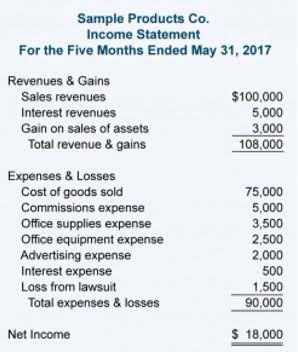
An accounting staff can produce massive amounts of data, and many reports are produced with a single click (if it’s not so, then make it so!). Prevent information overload by discussing what data the accounting department will produce and how often. Lack of standardization can impact everything from your ability to generate accurate financial statements in a timely fashion to closing the books.

How to Choose the Best ERP for Your Business
- With 150 pre-built reports and a custom report writer with a drag-and-drop interface, Intacct offers both ease of use and depth in reporting.
- However, you’ve probably noticed that some transactions occur strictly between affiliates (either the parent company and a subsidiary or a subsidiary and another subsidiary).
- Automated approvals and real-time transaction monitoring add additional layers of protection, while detailed audit trails simplify the process of preparing for audits or regulatory reviews.
- Comparative financial statements make it simple to obtain accurate information about whether branches are failing or overperforming, allowing you to establish benchmarks for the future.
- It’s simpler to evaluate what’s succeeding when using multi-entity accounting software, whether it’s a particular product or region.
- The software solutions available provide a wealth of features and integrations to help you succeed financially, manage your finances, optimise workflows, and boost overall productivity.
Even standard company operations like accounting frequently entail using distinct workflows. Although the shift to multi-entity accounting systems like Xledger carries undeniable benefits, particular challenges require careful navigation regardless of your chosen software. What matters is choosing the software you can trust to help you navigate these challenges confidently—and that’s precisely what makes Xledger the #1 choice for multi-entity accounting. In this case, the parent company is responsible for recording the transaction and any profit or loss. The transaction is not transparent to the subsidiaries, only the parent company and its stakeholders.
What is multi-entity reporting?

Over the past four months, ongoing tariff uncertainty has driven global markets into flux. A multi-entity company is any company that has an ownership stake in various subsidiary companies. Book a personal live demo real estate cash flow to see how Eleven can streamline your accounting practice and tasks. Several CPA and accounting firms have implemented MEA, drastically improving their accounting process.
- It is a testament to the adaptability and foresight required to thrive in today’s intricate business environment.
- These transactions involve the transfer of goods, services, or funds between subsidiaries, divisions, or the parent company.
- Despite its separate legal status, the subsidiary remains closely tied to the parent organization, contributing to its overall financial landscape.
- In this post, we’ll discuss what multi-entity accounting is, how to execute an efficient multi-entity accounting process, best practices, and how to choose a multi-entity accounting software solution.
Intercompany Transactions and Eliminations
If found non-compliant with certain tax or reporting regulations, the company could face penalties, fines, or other legal consequences. Multiview’s ERP provides our clients with a comprehensive software suite that empowers their finance teams to advance their organizations. It’s common for a company to need or have different sets of books for internal accounting, tax reporting, and public financial reporting. This gets more complicated when the company operates in multiple jurisdictions with different tax laws and public accounting principles. The software used for multi-entity accounting typically includes features like intercompany eliminations and automated reporting, making it easier to manage complex financial structures.
- It also enables consolidated financial management, helping businesses oversee transactions and interactions between their entities.
- All existing user configurations and system settings are also maintained when Intuit Enterprise Suite links your accounts.
- Fortunately, there are accounting softwares with features designed to help you run multiple locations from one central hub, and these options include QuickBooks, Xero, Sage Intacct, and NetSuite.
- When you hear about multi-company accounting, you are talking about the intricate task of managing the financial affairs of distinct companies, whether they are interconnected subsidiaries or independent entities.
- By providing access from all entities, MEM enables you to compare performances across different subsidiaries or regions, highlighting strengths and weaknesses to foster improvement measures.
Unravelling Tax Relief Challenges
In accounting, an ‘entity’ refers to the business or segment whose financial activities must be recorded, monitored, and analyzed independently. Recognizing bookkeeping the entities within your corporate structure is pivotal for precise financial reporting, budgeting, and strategic planning. Intercompany debt is eliminated when a parent firm lends money to a subsidiary, and each party has a note payable and a note receivable.

The challenges of multi-entity accounting can vary depending on the company’s size, the diversity of its operations, and the regulatory environments in which its entities operate. Tipalti also offers advanced FX products working in combination with its AP automation software for foreign currency conversion into local currency, supporting 30 currencies and transaction hedging. These optional add-on products, which are ideal for multi-entity companies and subsidiaries with foreign exchange, are Tipalti Multi-FX and Tipalti FX Hedging. You can use Tipalti’s what is multi entity accounting multi-entity features with an ERP system or accounting software that provides multi-entity capabilities. Examples of ERPs with multi-entity functionality are NetSuite OneWorld, Microsoft Dynamics 365 Business Central, and Sage Intacct.


Each entity needs to be able to track financial performance individually, though still facilitate reporting for the organization as a whole. This may be due to the workload, but it could also only be because separate systems are in use and employees are underutilized. That seems simple, except the company has currency in U.S. and Canadian dollars, the euro, Japanese yen, and a dozen other currencies. If it wants a total balance in U.S. dollars, it has to account for the fact that all the other currencies are changing in value every minute. Tap into an ERP suite with accounting features like Intuit Enterprise Suite to see how it can help your business thrive.

0 Responses to What is Intuit Enterprise Suite? Intuit